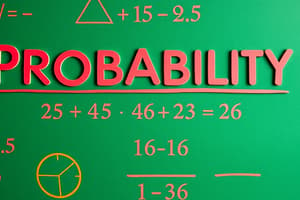Podcast
Questions and Answers
What is the probability of observing an outcome from the sample space?
What is the probability of observing an outcome from the sample space?
- Undefined
- 0
- 1 (correct)
- 0.5
Which formula correctly calculates the probability of the union of two events A and B?
Which formula correctly calculates the probability of the union of two events A and B?
- P(A union B) = P(A) + P(B) - P(A cap B) (correct)
- P(A cap B) + P(A) + P(B)
- P(A) + P(B)
- P(A) - P(B) + P(A cap B)
What does the area of intersection in a Venn diagram represent?
What does the area of intersection in a Venn diagram represent?
- The probability of both events A and B occurring at the same time (correct)
- The total probability of event A
- The probability of either event A or event B occurring
- The total probability of event B
What is the result of adding the probabilities of two events without considering their intersection?
What is the result of adding the probabilities of two events without considering their intersection?
If P(A) = 0.3, P(B) = 0.5, and P(A ∩ B) = 0.1, what is P(A ∪ B)?
If P(A) = 0.3, P(B) = 0.5, and P(A ∩ B) = 0.1, what is P(A ∪ B)?
What happens if P(A ∩ B) is equal to zero?
What happens if P(A ∩ B) is equal to zero?
What does the probability identity for the union of two events help to correct?
What does the probability identity for the union of two events help to correct?
If two events A and B have no overlap, what is the identity used to calculate P(A ∪ B)?
If two events A and B have no overlap, what is the identity used to calculate P(A ∪ B)?
Which of the following statements best describes the relationship between probabilities of individual events and their union?
Which of the following statements best describes the relationship between probabilities of individual events and their union?
What geometric representation can be used to better understand the probability identity for the union of events?
What geometric representation can be used to better understand the probability identity for the union of events?
In the formula P(A ∪ B) = P(A) + P(B) - P(A ∩ B), which term accounts for the overlap between events?
In the formula P(A ∪ B) = P(A) + P(B) - P(A ∩ B), which term accounts for the overlap between events?
What is the mathematical notation for the sample space's probability?
What is the mathematical notation for the sample space's probability?
What is the total probability represented when correctly applying the union identity for two events A and B?
What is the total probability represented when correctly applying the union identity for two events A and B?
If the probability of event A is 0.4 and event B is 0.6, what happens to the calculation of P(A ∪ B) if P(A ∩ B) is significantly high?
If the probability of event A is 0.4 and event B is 0.6, what happens to the calculation of P(A ∪ B) if P(A ∩ B) is significantly high?
Which aspect is corrected by subtracting P(A ∩ B) in the union probability identity?
Which aspect is corrected by subtracting P(A ∩ B) in the union probability identity?
What does the equation P(S) = 1 imply about the sample space in probability theory?
What does the equation P(S) = 1 imply about the sample space in probability theory?
When visualizing probabilities using Venn diagrams, what does the area representing P(A) + P(B) indicate before correction?
When visualizing probabilities using Venn diagrams, what does the area representing P(A) + P(B) indicate before correction?
Which statement accurately describes the relationship between probabilities in the provided equations?
Which statement accurately describes the relationship between probabilities in the provided equations?




